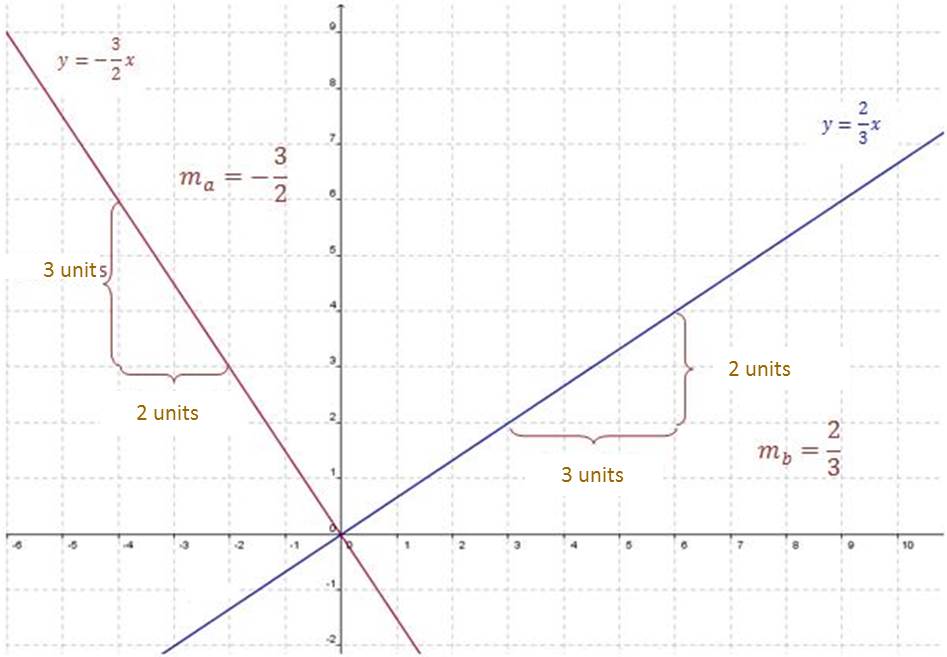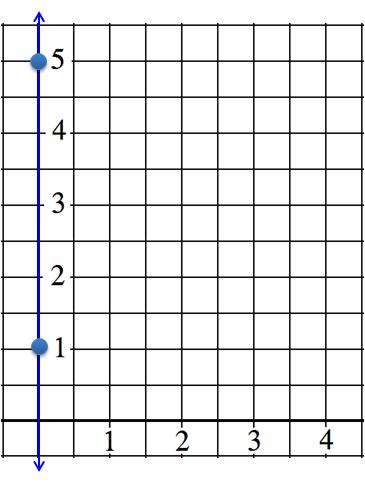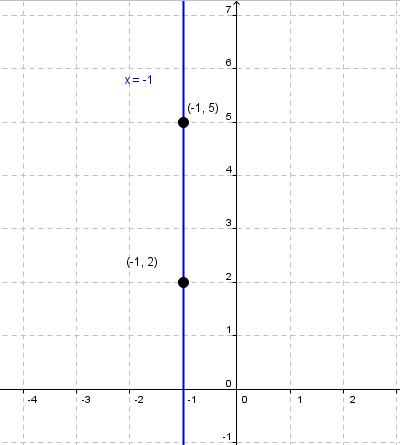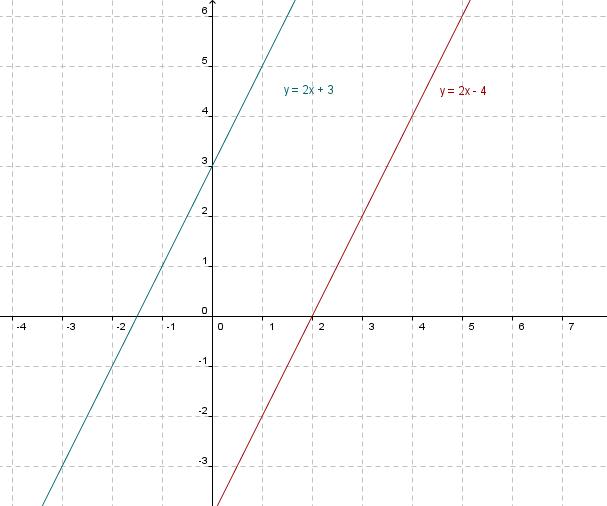Linear Equations with Two Variables - Part 2
After completing this lesson, you will be able to:
- Identify if two lines are parallel.
- Identify if two lines are perpendicular.
- Identify and find the formula of vertical lines.
- Recognize and use different formulas for a linear
relationship.
In the lesson on Linear Equations —
Part 1, you saw is a line with slope m and y-intercept b. Next, you will
explore several relations between lines and alternatives to
representing lines by y = mx + b.
Two parallel lines can be described in a variety of ways:
- Two lines in a plane that never intersect.
- Two lines which maintain a constant distance between them.
- Two lines with the same slopes.
To solve mathematical problems, generally it is simpler to characterize
parallel lines as two lines with the same slopes.
Examples:
Example 1: The lines
and are parallel.
Example 2: Follow the instructions in the
application below and observe the effects of different changes in the
formulas of the line graphs:
- Move the slider m1 until the two lines are parallel.
- Now, move the slider b1 from b1 =
-5 until b1 = 5. Changing the y-intercept
b1 does not change the slope of the line. So the
value of the y-intercept does not have any affect on whether the
lines are or are not parallel. If the slopes of the two lines are
the same, then the lines are parallel.
- Move the red sliders until you change the formula of line 1 to
y = 2x + 1. Then move the blue sliders to
find the formulas of four lines parallel to
y = 2x + 1.
- Move the red sliders until you change the formula of line 1 to
y = -3x + 4. Then move the blue sliders to find
the formulas of four lines parallel to y = -3x
+ 4.
Example 3: Find the equation of the line that passes through point
(3,2) and is parallel to line
.
Solution:
- The slope of
is equal to 2.
- The slope of a
line parallel to
has to be 2 also. So, the parallel line has to have a
formula .
- If the formula
of the line is y = 2x + b, what's
left is to find the value of y-intercept b. If the line
passes through point (3,2), by substituting 3 for x in the
formula, the result (the value of y) has to be 2. So:
- Substituting 3 for x and 2 for y in
the formula y = 2x + b,
gives 2 = 2 x 3 + b
- Now you can solve for the value of b which will make
the equation true:
2 = 6 + b
2 – 6 = b
–4 = b
- So the formula of the line which passes through point (3,2) and is parallel to line
y = 2x + 3 is
- Verification
- y = 2x + 2 and y = 2x - 4 have the same
slope 2. Therefore, they are parallel.
- Point (3,2) satisfies formula y = 2x - 4 because
substituting 3 for x and 2 for y results in:
2 = 2 × 3 - 4, which is true.
So line y = 2x - 4 is parallel to line y = 2x + 3 and
passes through point (3,2), which can be seen with the graphs of the
two lines.
Two perpendicular lines are frequently described in one of two ways:
- Two lines that form 90 degree angles where they intersect.
- Two lines of a plane where the product of their slopes is -1.
To solve mathematical problems, the characterization which is most
used is: two lines where the product of its slopes is -1 are
perpendicular.
Examples:
Example 1: If the slope of a line is
, then for each 3 units the coordinate of x
moves to right on this line, the coordinate of
y is increases by 2 units.
According to the characterization, a line which is perpendicular to
this line will have a slope of
. In the perpendicular line, for every 2 units the coordinate of
x moves to right, the
y coordinate decreases by 3. (Or for every 3 units
that the coordinate y moves up, the
coordinate x decreases by 2.)
Example 2: Follow the instructions on the application below and observe the effects of changes to the formula on the
line graphs:
- Move the slider m1 until both lines are perpendicular.
- Now, move the slider b1 from b1 = -5 until
b1 = 5. Changing the y-intercept b1 does not change the
slope of the line. So the value of the y-intercept has no effect on
whether the lines are or are not perpendicular. If the product of
the two slopes is -1, then the lines are perpendicular.
- Move the red sliders until you change the formula of line 1 to
y = 2x + 1. Then move the blue sliders to
find the formulas of four lines perpendicular to
y = 2x + 1.
- Move the red sliders until you change the formula of line 1 to
y = -3x + 4. Then move the blue sliders to find
the formulas of four lines perpendicular to y =
-3x + 4.
In the following diagram, the two points (0,1) and (0,5) are labeled
and there is a line drawn which passes through the two points. In
Linear Equations - Part 1, we saw that slopes
can be expressed in different ways:
- Slope m equals the amount that y changes when
x increases by 1.
- m = rise/run = Δy/Δx
- rise = m × run or Δy = m × Δy
In the case of two points (0,1) and (0,5), the value of x is
constant. Therefore, x never increases by 1, never advances
and, as a consequence, Δx is
zero in all cases. So the slope is not defined for the line that passes
through these points. The usual intercept-slope formula y
= mx + b does not represent the set of points that
belong to this or any other straight vertical line. By examining various
points which belong to this line, such as
(0,-1), (0,0), (0,1) and (0,2),
we observe that the x coordinate is zero at any and all points. So a formula
for the line is x = 0.
In general, with vertical lines:
- The value of x does not change and the equation is
expressed in the form of
, where a is a constant.
- Δx is equal to zero. The slope of a vertical line is not
defined and we say that a vertical line has no slope.
Examples:
Example 1: Determine the equation of the line which passes through
points (-1,2) and (-1,5).
Given the first coordinates of both points is the same, the only possibility is
that the line which passes through two points is a vertical
line, in other words, for any value for y, the value of
x has to be -1. So the equation of the line would be:
x = -1.
Example 2: Follow the instructions on the application below
and observe the effects of changes in the formulas
on the line graphs:
- Move point J until it is on top of point (2,0). You will
observe the equation of line, x = 2 written in red.
- Move the blue slider until the value is 4 to see four points labeled on the
line. Verify that the four points satisfy the equation
x = 2.
- Move J until the four vertical lines correspond to
x = -1, x = -3, x = 0 and x =
3. For each line, verify that the four points satisfy the equation
of the line labeled in red.
Until now, we have used y = mx + b to represent non-vertical
lines. This way of representing a line is called slope-intercept. There are
circumstances where other forms of expressing the equation of a line are
more useful:
- Point-Slope: Given that a line which passes through (2,3) with
a slope equal to 4. Any other point (x,y) on the
line has to serve to calculate the slope of the line. Since the
slope is 4, y − 3 / x − 2 has to be 4, in other words:
When you multiply the two sides of the equation by (x
- 3) we get the form (equation) known as point-slope:
(y - 3) = 4(x - 2)
Generally, you can represent the line with slope m
which passes through point (a,b) with the point-slope equation:
(y - b) = m
(x - a)
By habit, we write the equation to calculate the
value of y. In this case, the
point-slope equation will be:
y = m(x - a) +
b
- Standard Formula: When a line is written as ax +
by = c, we say the equation is in the standard form.
The standard form is very useful to find the x and y-intercept. For example, in the case of equation 2x
+ 4y = 8, when x = 0, the equation becomes 4y = 8.
Therefore y = 2 is the y-intercept.
When y = 0 (substituting 0 for y) the equation becomes 2x = 8. Therefore x = 4
and the intercept of the x axis is 4. With the two
intercepts (0,2) and (4,0), you can plot the graph of the line
efficiently. See the following graph and confirm that all the
points on the line satisfy the equation 2x + 4y =
8.
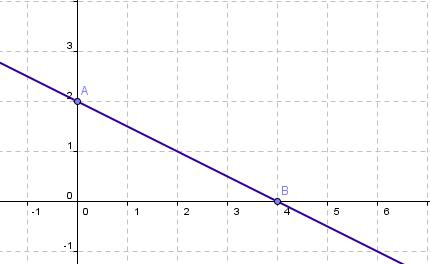
Generally, if ax + by = c, the intercepts are
and .
To practice representing lines in various forms, follow the
instructions on the application below.
- With the blue sliders, select m = -1 and b =
20. The graph which results should be y = -1x + 20 with slope -1 and y-intercept (0,20).
- Click on the green text labeled Point-Slope.
Move the green point on the line labeled P to the
following points. Write down the point-slope formula shown for each point.
| P |
Point-Slope Formula |
Point-Slope Formula |
| (20,0) |
(y – 0) = –1(x – 20) |
y = –1(x – 20) + 0 |
| (0,20) |
(y – 20) = –1(x – 0) |
y = –1(x – 0) + 20 |
| (-20,40) |
(y – 40) = –1(x + 20) |
y = –1(x + 20) + 40 |
- Verify that all the resulting formulas are equivalent to the
slope-intercept formula y = - x + 20.
- Click on the red text labeled Standard
Form. With the red sliders, select intercepts L =
20 and M = 20. Verify that the line which has intercepts
(0,20) and (20,0) is identical to the line seen on the previous
steps and that its standard form is x + y = 20 is
equivalent to the slope-intercept formula:
y = –x + 20
- To practice, use the application to express the following lines
with formulas in the point-slope form and in the standard form:
- y = -2x + 40
- y = 2x - 30
- y = -5x + 30
- y = 6x - 20
Now that you have completed this lesson, you will be able to:
- Identify if two lines are parallel.
- Identify if two lines are perpendicular.
- Identify and find the formulas of vertical lines.
- Recognize and use different formulas to represent a
linear relationship.
|

